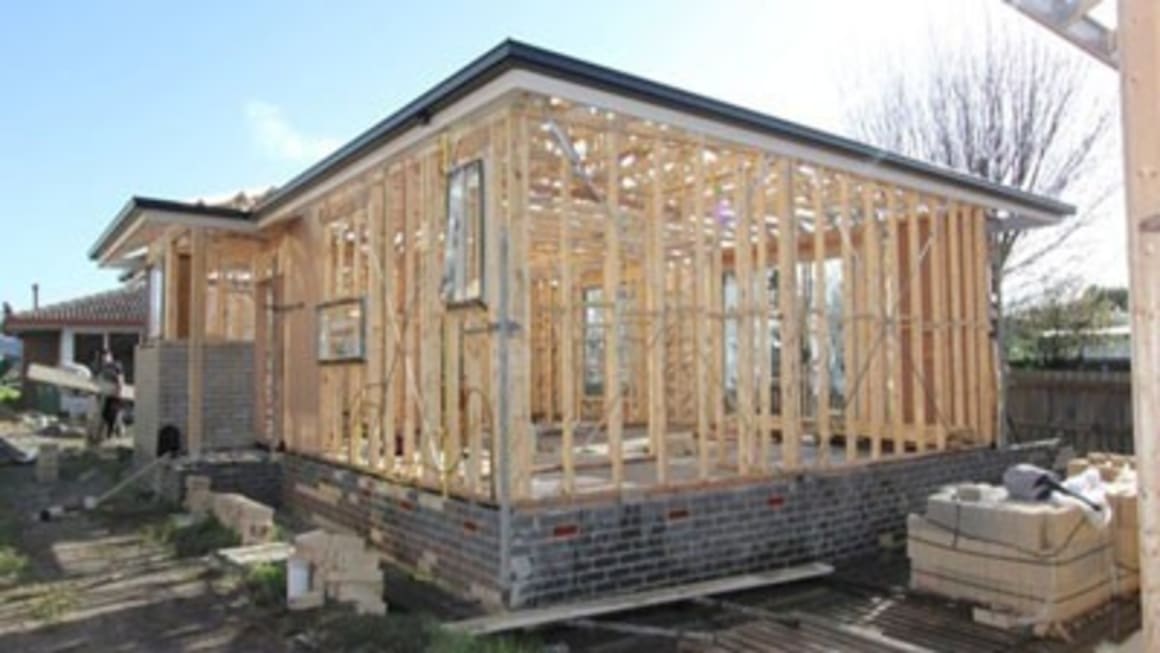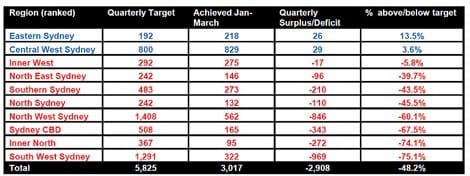Sydney housing crisis deepens as outer suburbs fall further behind on new home building targets: McKell Institute

Sydney fell further behind on its new home construction targets in the first quarter of the year, according to social policy think-tank the McKell Institute.
In its inaugural quarterly housing monitor report for the first quarter of 2012, the McKell Institute calculated there were 3,017 new home completions, just over half (52%) of the 5,825 new dwellings that are required to meet the Sydney 2036 metropolitan target – a shortfall of 2,908 homes.
The institute says that under Sydney metro targets dating back to July 2006 until the first quarter of 2012, Sydney should have delivered 133,975 new homes.
However, over this period Sydney has delivered only 80,466 new homes, a deficit of 53,509 homes (or roughly 40%).
The biggest shortfall of new homes is occurring in the outer north-west and outer south-western suburbs of Sydney, where the government expects more than 40% of new homes to be built between now and 2036.
The McKell institute calculated that in the first quarter of the year just 322 homes were built in south-west Sydney – comprising Camden, Campbelltown, Liverpool, Wollondilly – 1,291 fewer than required under NSW government targets, and representing a shortfall of 75.1% for the quarter.
Similarly, in the north-west growth corridor – comprising Blacktown, Blue Mountains, Hawkesbury, Penrith and The Hills – there were only 562 homes built, compared with a target of 1,408 – a shortfall of 60.1%.
Just two zones met their targets in the first quarter of the year, including eastern Sydney, which has the smallest government requirement and comprises some of the most expensive property in the city in the suburbs of Botany Bay, Randwick, Waverly and Woollahra.
The other zone to meet its target was central west Sydney – incorporating Auburn, Bankstown, Fairfield, Holroyd and Parramatta – which has a target of 96,000 by 2036.
Metro 2036 target, quarterly, first quarter 2012
Click to enlargeThe quarterly targets are calculated based on December 2010 NSW government modelling, which estimates that Sydney needs an additional 770,00 homes by 2036 – a 46% increase on the current 1.68 million homes – to cater for an additional 1.6 million people by this time, taking the city’s population to over 6 million residents.
The greatest concentration of houses is required in the south-west, where the NSW government has a target of 155,000 new homes by 2036, and the north-west – Blacktown, Blue Mountains, Hawkesbury, Penrith, The Hills – where the target is for 169,000 homes to be built by 2036.
The McKell report also quotes Australian Property Monitors (APM) statistics which show that Sydney’s median weekly asking rent for a house is $500 compared to Melbourne’s which is a far more affordable $360 per week, whilst the median price for a home in Melbourne is $531,000 compared $642,000 in Sydney.
It also notes that fewer than one-third of Sydney residents under the age of 35 own a home, while over the last five years, Sydney’s housing approvals numbered 98,822, compared with 192,648 in Melbourne.
“These [undersupply] figures ought to sound an alarm bell for the newly elected councillors across Sydney who need to understand that home ownership is becoming a preserve of the wealthy,” says McKell Institute executive director Peter Bentley.
McKell fellow and author of its Homes for All report (which set even higher new home construction figures) Sean Macken say the figures suggest the housing situation is going to get much worse in a city which is already Australia’s most expensive to buy or rent a home
“Councils across the city need to flatly reject NIMBYism and accept that if they don’t approve more dwellings and get the construction sector pumping, our housing affordability crisis will get out of control.”
At last week’s BIS Shrapnel forecasting conference, it was reported that NSW would have a dwelling stock defiencey of 52,800 homes by 2014 at current rates of construction.
BIS Shrapnel warned of “significant stock defiencies” emerging, particularly in Sydney, and forecast an “upturn in residential building" in NSW and other states with undersupply issues.
The undersupply of new homes in Sydney is also one of the factors “creating signficiant pressure in residential property markets, driving price and rental growth and ensuring Sydney remains the least affordable capital city in Australia," says BIS Shrapnel.
BIS Shrapnel says the high level of unaffordability has been a significant contributing factor in the lack of new houses being built in NSW, “alongside a complex planning framework and lack of suitable land releases”.
